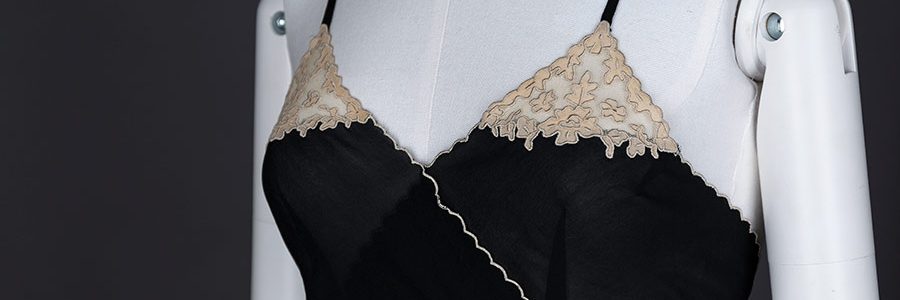#UPMTC: The role of women in the history of underwear, by Susanna Cordner
This is the second of our blog posts documenting the first Underpinnings Museum Twitter conference. It focuses on the presentation from our keynote speaker Susanna Cordner, which followed Karolina’s introduction to the day. Susanna is currently Senior Research Fellow: Archives at London College of Fashion, UAL, where she looks after the archive collections and curates Sartorial Stories, a series of talks where fashion industry guests are invited to discuss their sartorial choices, careers and work. She also works at the Victoria & Albert Museum and assists with curation of exhibitions including Undressed: A Brief History of Underwear.
1 #UPMTC Hi! I’m going to explore some roles women have held in the history of underwear C18th – 1960. We know that underwear can be used to literally shape women – but, importantly, women have also used underwear (designing, making, even laundering it) to shape their own careers
— Susanna Cordner (@Susanna_Cordner) January 12, 2018
2 #UPMTC Until washing machines became standard, most households relied on a laundry maid or a ‘send out’ service, either to a washhouse or a woman working from her home, to keep their smalls clean. This was hard and physical work – but it was also a large employer for women.
— Susanna Cordner (@Susanna_Cordner) January 12, 2018
3 #UPMTC Historically, women didn’t just care for the cloth our underclothes were made of – they used it to construct garments, too. From the 1780s increasing numbers of women ran stay & corset making businesses. From the 1860s corset factories also employed a lot of women.
— Susanna Cordner (@Susanna_Cordner) January 12, 2018
4 #UPMTC One such female corset maker was the great inventor & writer Roxey Ann Caplin. Roxey invented over 20 corset styles designed to suit active modern women & won the ‘Manufacturer, Designer & Inventor’ medal for 1 of her corset designs at the Great Exhibition, London, 1851.
— Susanna Cordner (@Susanna_Cordner) January 12, 2018
5 #UPMTC Roxey believed, if fitted and laced correctly, corsets were beneficial to women’s health. She wrote a book in their defence, which included guides on how to exercise in your corset, and she set up exercise gyms for women in London & Manchester. pic.twitter.com/iT187XlnHO
— Susanna Cordner (@Susanna_Cordner) January 12, 2018
6 #UPMTC In her book ‘Health and Beauty: or, Woman and Her Clothing . . .’ (1850), Roxey stated: ‘The principal writers upon the subject of corsets have been medical men, who, great as is their knowledge of their part of the question, certainly know nothing of ours.’
— Susanna Cordner (@Susanna_Cordner) January 12, 2018
7 #UPMTC Madame Dowding was another notable C19th corsetiere. Based in London, she advertised widely in the press. As a branding trick, her corsets for men tended to be named after battles, while her corsets for women had names which referred to princesses and queens. pic.twitter.com/2MpErzkLLx
— Susanna Cordner (@Susanna_Cordner) January 12, 2018
8 #UPMTC Another female inventor in the field was Mary Bliss, who created Stesroc corsets (yep, that’s ‘corsets’ backwards…) in the 1890s-1900s. These corsets focused on comfort, ease of movement & sometimes had shoulder straps to better support the bust. pic.twitter.com/3kRohY04gs
— Susanna Cordner (@Susanna_Cordner) January 12, 2018
9 #UPMTC Female inventors also held an important role in the development of the bra, with the 1st patents for many innovations taken out by women – incl. maternity bra by Emma Goodman (1888), sports bra by Laura B. Lyon (1904) & first underwire support by Madeleine Gabeau (1909)
— Susanna Cordner (@Susanna_Cordner) January 12, 2018
10 #UPMTC In 1928, Rosamond L. Kennedy, another Londoner in this history, invented the Kestos brassiere, made of two overlapping triangular cups supported by slender straps which buttoned at the side. She named it after the garment the Greek goddess Juno wears in the ‘Iliad’.
— Susanna Cordner (@Susanna_Cordner) January 12, 2018
11 #UPMTC Leaping ahead, Anne-Marie Lobbenberg was a key C20th female underwear innovator who designed the ‘Little X’ girdle for Silhouette in 1958. Aimed at active young women, ads showed models jumping around, demonstrating that the girdle ‘Won’t wrinkle, roll over or ride up’. pic.twitter.com/ztmQofebAW
— Susanna Cordner (@Susanna_Cordner) January 12, 2018
12 #UPMTC I could go on & on, but time is up… From domestics to designers, launderers to inventors, consider this just an intro to some of the female innovators in the history of underwear who built foundations for both their bodies & their careers. Thank you for reading along!
— Susanna Cordner (@Susanna_Cordner) January 12, 2018
We will share each of the conference presentations via its own blog post over the coming weeks. If you’re on Twitter, you can join the discussion via the Underpinnings Museum’s account and the conference hashtag #UPMTC
The header image for this post is of a 1930s Kestos style bra from the Underpinnings Museum collections. Photography by Tigz Rice.
